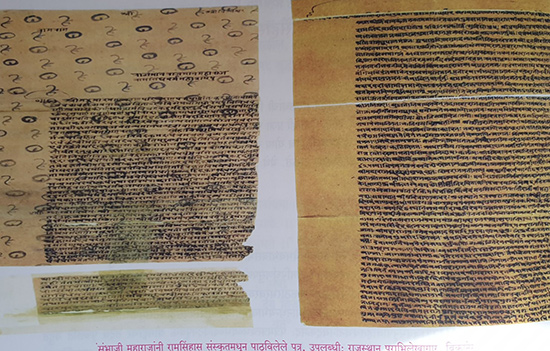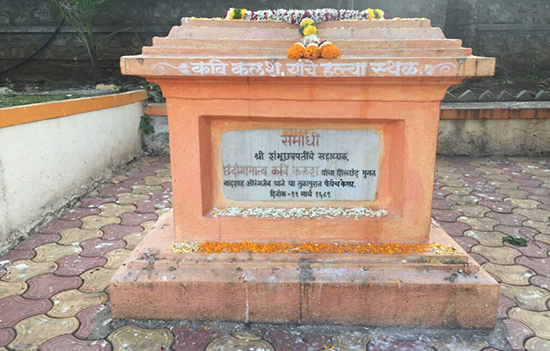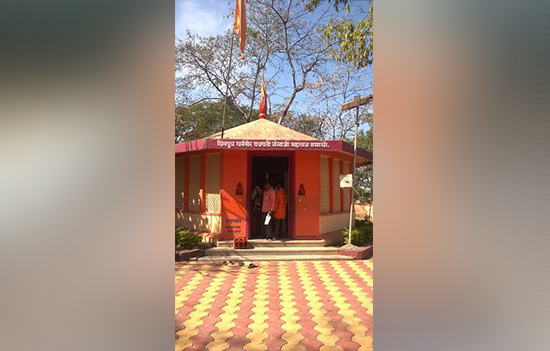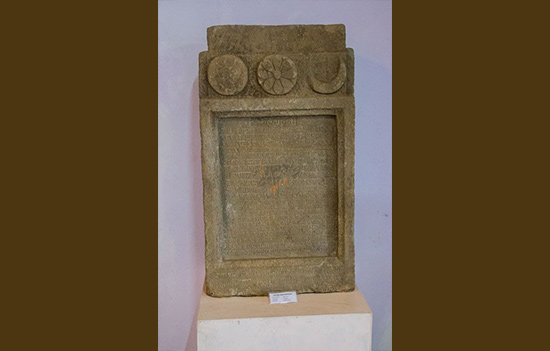- Chhatrapati Sambhaji, son of Shivaji
Maharaj, was killed by Aurangzeb because he refused to convert. His Queen Yesubai
and 8 years old son Shahu were made prisoners. Yesubai was in custody for 30
years and Shahu 17. Aurangzeb failed to convert Shahu.
We Hindus are all considered to be effeminate and tint by the wicked Emperor (Aurangzeb) at the moment. (He thinks) We have completely forgotten about our religion. We can no longer tolerate the Emperor's attitude in this way. We cannot tolerate anything that disparages our Kshatriya heritage. The Vedas and the Smritis impose a number of religious rules on us that we must adhere to. We must also fulfill our responsibilities as kings to our subjects. In order to wage war on this satanic Emperor, we are prepared to give up everything, including our treasure, land, and forts. - Sanskrit letter by Chhatrapati Sambhaji to Maharaja
Ram Singh of Amer, written in November 1682 1
The reasons for Asylum to Akbar II (son of Aurangzeb)
‘As the world does not stay in the same condition,
It is better to have a good name, which will endure as a memorial.’
-Prince Akbar’s letter to Chhatrapati Sambhaji Maharaj in 1681 2
After Akbar II’s (Prince Akbar) failure to capture the Mughal throne from Aurangzeb, with the help of Mewar and Marwar in early 1681, he and Durgadas Rathore left Rajputana and started moving towards Deccan. A letter written by Akbar-II in May 1681 throws a clear light on the policies of Aurangzeb.
“From the beginning of his reign, it was the intention of the Alamgir to ruin all the Hindus alike. On the death of Maharaja Jaswant Singh, this intention became revealed to all. His war with the Rana (Maharana Raj Singh-Mewar) was also the outcome of the same design).” 3
Chhatrapati Sambhaji's first plan was to assist Akbar II in making a new foray into Rajputana and reviving the revolution there. Due to Rathore's unresolved grievance and geographical proximity to Delhi-Agra, they were able to effectively challenge Mughal might in their own backyard. Aurangzeb would be forced to retreat completely or divide his forces into both war zones as a result of this serious threat that emerged so close to his capital, putting less pressure on the Deccan. The Maratha armies could make then a pincer movement against the Mughals through Malwa.
The main reason Akbar was supported was to install a weak Mughal king on the throne, where the real power would be with the kingmaker. In fact, Akbar explicitly says so in a letter that he sent to Chhatrapati Sambhaji. Quote, “The name will be mine (Akbar) and the State will be yours (Chhatrapati Sambhaji)” if he won the throne. 4
That was the reason Sambhaji Maharaj supported Akbar against Aurangzeb. If Akbar went to Persia and according to his own plans got help from Safavid to get the Peacock throne, effective control over him and thereby India would pass over to the Safavids. This would be a significant threat to India's long-term civilizational prospects, as Chhatrapati Sambhaji made this abundantly clear in this Sanskrit letter to Maharaja Ram Singh of Amer.
 Sanskrit letter of Chhatrapati Sambhaji to Maharaja Ram Singh. Credit Rajasthan State archives/ Dr. Uday Kulkarni
Sanskrit letter of Chhatrapati Sambhaji to Maharaja Ram Singh. Credit Rajasthan State archives/ Dr. Uday Kulkarni
Capture of Bijapur and Golkonda
When Aurangzeb came to Deccan in 1681, his first target was the Maratha Empire. After fighting Chhatrapati Sambhaji’s tactics, with little success, for four years the morale in the Mughal encampment started nose-diving. The long-drawn siege of forts like Ramsej further impacted the confidence of the Mughal army.
By then, even Adil Shahi and Qutb Shahi had finally realized the need
for cooperating with the Marathas. Hence they started providing material and
monetary support to Chhatrapati Sambhaji (especially Qutub Shah, who was an old
ally of Marathas from 1670s). 5 To
boost the morale of his army with an easy victory and to break this coalition,
Aurangzeb changed the direction of the campaign to Bijapur in early 1685. 6
Having besieged the fort of Bijapur for over a year, the Sikandar
Adil Shah finally surrendered in September 1686. “The banners of Islam which had been turned upside down
in this country for a long time again uplifted their heads. From every single
side of the earth, the cry ‘Truth came, and falsehood vanished’ rose to the vault of the sky” described Saqi Mustaid Khan
with delight. 7
After the surrender of Bijapur, the king was re-titled Iskandar
Khan and remained a prisoner of war till his death in April 1700. He was
neither humiliated further nor tortured by Aurangzeb or any of his cronies and pensioned
off for an annual amount of Rs 1 lakh. 8
Similarly, Golkonda was besieged in early 1687 by the Mughal
forces. On 21st September 1687, due to the treachery of Abdullah
Panni who opened a side gate to let the Mughal forces enter, the resistance of
Qutb Shahi forces crumbled, and the fort was captured after eight months of a long
siege. 9
Aurangzeb soon packed Qutub Shah off to the Daulatabad fort
(Deogiri) in Maharashtra as a prisoner-of-war along with Adil Shah (who later
became his son-in-law) on a pension of fifty thousand rupees per year. 10 Qutb Shah died in the Mughal captivity in the same fort. Even after the choicest abuses by Aurangzeb’s chroniclers, Abul Hasan Qutb Shah was, after his capture, neither humiliated in public nor tortured in captivity.
The
Supreme Sacrifice
यावन रावण की सभा, संभू बंध्यो बजरंग।
लहु लसत सिंदूर सम, खूब खेल्यो रनरंग।
ज्यो रवि छवि लखत ही, खद्योत होत बदरंग।
त्यो तुव तेज निहारी के तखत तज्यो अवरंग।। “Hanumanji, even when tethered, was standing tall in the court of Asur Ravan,
O my King, in the court
of Yavan Aurangzeb, you are standing with the same pride.
As we coat Prabhu Hanuman’s body in Sindoor,
O, my King, your body is
similarly bloodied from the battle.
As the Sun starts to
shine, the firefly takes the flight,
Likewise, Aurangzeb, unable to bear your radiance, has come down from his throne.” - Kavi Kalash (Poet and close friend of Chhatrapati
Sambaji Maharaj.
In early 1689, when Aurangzeb had encamped at Akluj the news that he was desperately waiting for reached him. Saqi Mustaid Khan summarizes this as, ‘The merry music of victory, which the ears of Muslims had been expecting, resounded through the sky. Satan was chained. Through the power of Emperor's fortune, the infernal infidel Sambha was made prisoner by army.’ Due to this news, the name of the Akluj was changed to Asadnagar by Aurangzeb. 11
In a letter written to Subhan Quli, Khan of Bukhara in 1684, Aurangzeb laid bare his intentions and what punishment he had in mind for Chhatrapati Sambhaji. He had confirmed in the letter that, “The rebel (Prince Akbar) may
be captured, but the unbeliever (Chhatrapati Sambhaji) must be eliminated.
Meanwhile, his territory was ravaged by Imperial armies and was annexed to the
Imperial domain. Though he wishes to submit to the Court, it is proper to
uproot that evil person and totally destroy him completely.” 12
Thus, we can see that the torture and humiliation began as soon as Chhatrapati Sambhaji and Kavi Kalash were taken captive by Sheikh Nizam Haidarabadi at Sangameshwar. From Sangamweshwar until they arrived close to Aurangzeb's camp at Bahadurgarh (i.e. on the bank of river Bhima) they were dragged by their hair and subjected to severe beating.
‘The Emperor out of his devotion to Islam ordered that from 2kos (4kms) before the camp the disgraced and unlucky Sambha should be made to wear ‘Kulahi-Zaugula’ (wooden cap which was the badge of condemned criminals in Mughal court). He and his comrades were dressed like buffoons, punished in various ways, mounted on a camel, and brought to the camp as well as in the Darbar with drums beating and trumpets pealing so that Muslims might be heartened and the infidels disheartened by seeing it. The night preceding this spectacle was celebrated like shab-i-barat because nobody slept. The day was like Id because all men old and young went out to enjoy scenes of joy and happiness’ wrote Saqi Mustaid Khan triumphantly. 13
Aurangzeb was so happy that Chhatrapati Sambhaji, who had escaped at
least thrice from his deadly embrace (1666 Agra, 1669 Aurangabad, 1679 from the
camp of Diler Khan), was finally captured.
Before the start of his Deccan campaign, as early as 1681, Aurangzeb
issued an order that all prisoners who convert to Islam would be released from
the Mughal captivity. 14 However,
trying such tricks with Chhatrapati Sambhaji was futile.
जीवितं मृतकं मन्ये देहिनां धर्मवर्जितम
मृतो धर्मेण संयुक्तो दीर्घजीवी भविष्यती
-Chapter 2
Rajniti, Shlok-611, Budhabhushanam by Chhatrapati Sambhaji.
Translation: Those who don’t follow the Dharma should be considered dead even while they are alive, whereas those who follow the Dharma are certain to live longer (in memory) even if they are dead. 15
The
torture that was inflicted on Chhatrapati Sambhaji and Kavi Kalash for over a
month was beyond description. They were whipped, had saltwater poured on open
wounds to exacerbate pain, had hot iron rods driven through their eyes, and tongue
cut by swords. 16
But even after such brutal torture, they were unsuccessful in breaking Chhatrapati Sambhaji and Kavi Kalash or getting any information that was remotely helpful to Aurangzeb. Hence, his council of theologians gave the verdict, ‘By looting Islamic cities and slaughtering or imprisoning Muslims, seeing the sin that this infidel (all the insults given to Chhatrapati Sambhaji by the Mughal chroniclers) had committed from this filthy religion and who was destined to go to hell, the reasons for keeping him alive were discussed. According to a fatwa issued the dignitaries of the state and scholars it was decided that it would be appropriate to send this warlike thief to Hell.
So, on
21st Jamad-ul-Awwal julus 32 (regnal year) when the Emperor arrived at
Koregaon, He (i.e. Sambhaji Maharaj) along with Kavi Kalash, were sent to the
deepest hell with the sword that kills the infidels. The date of his death is
written as 'Kafir Bacha Jahannami Raft' meaning the son of an infidel went to Hell.’ 17
 Samadhi of Maharaj’s close friend Kavi Kalash. Pic credit Miscellaneous Bharat Blog.
Samadhi of Maharaj’s close friend Kavi Kalash. Pic credit Miscellaneous Bharat Blog.
 Samadhi of Chhatrapati Sambhaji Maharaj. Pic by Tripadvisor.
Samadhi of Chhatrapati Sambhaji Maharaj. Pic by Tripadvisor.
Their bodies had been chopped into pieces and left on the riverbank. The heads were paraded through all of Deccan's cities and towns while being stuffed with straw and accompanied by the beat of drums and trumpets, ‘so that Muslims might be heartened and the infidels disheartened by seeing it.” 18 Aurangzeb ordered the change of name
from Koregaon to Fatahabad-city of victory. 19
During his Deccan campaign, Aurangzeb attempted to annex three
kingdoms: Adil Shahi of Bijapur, Qutub Shahi of Golconda, and Hindavi Swarajya.
He achieved the first two objectives i.e. Bijapur in 1686 and Golconda Fort
(victory by trickery) in 1687. 21
However, despite Chhatrapati Sambhaji Maharaj's capture and execution (March 1689), the Hindavi Swarajya did not submit or fold in the face of the most brutal attack and the use of the full weight of the Mughal Empire's power against them for the following seventeen years. 22
Also read Queen
Tarabai who kept the Maratha Flag flying post Sambhaji Maharaj
Chhatrapati Sambhaji's actual captors, torturers, and killers received a barrage of gifts. The title Khan-i-Zaman
Bahadur Fatah Jung, a cash gift of Rs. 50,000, a suit of royal robes,
horses, elephants, jewelled arms, and a promotion to the rank of 7,000
horses were all given
to Muqarrab Khan alias Sheikh Nijam Hyderabadi. Ikhlas Khan, his son, was
elevated to the rank of 5,000 horses and given
the title Khan-i-Alam. The other sons
of Sheikh Nijam also received mansab, robes of honour, and various titles. 23
Sayyid Fath Muhammad, the chief hermit at the tomb of Mir Sayyid
Muhammad Gisudaraz (Gulbarga), who interpreted a dream to predict the capture
of Chhatrapati Sambhaji in the private conference with Aurangzeb was also
rewarded handsomely (Chhatrapati was captured within ten days of this meeting).
They received rent-free lands as inam
(gifts) in perpetuity. Aurangzeb also sent 10,000 rupees (equivalent to Rs.2
crore today) as a token of gratitude to the caretakers of the Gisudaraz tomb. 24
It seems the dark night of Falgun
(Amavasya) had befallen the dream of Hindavi Swarajya with the ghastly end of
Chhatrapati. Little did Aurangzeb or any of his courtiers realize then that
this was not the end; this was not even the beginning of the end but only the
end of the beginning.
The
Forgotten Sacrifice
Chhatrapati Sambhaji made the supreme
sacrifice for upholding his Dharma. Similarly, Maharani Yesubai (Queen of
Sambhaji (along with Ashta Pradhan Mandal (Maratha cabinet) decided to move Rajaram Maharaj to Ginjee (160km South of Chennai). However, she decided to stay and fight at Raigad (Shivaji’s capital) for the next seven months. Raigad was captured by the Mughal forces in October 1689, but Rajaram Maharaj had escaped to keep alive the flame of resistance. 25
Maharani Yesubai and the young Shahu Raje
(then only eight years old) were made prisoners and were kept in a separate
section of Gulalbar camp.
Apart from the war with the Marathas,
another war of wits was fought between Aurangzeb and Maharani Yesubai. It
continued for the next 17 years. The former tried every trick but Maharani
Yesubai gave the right upbringing to Shahu Raje as he continued to defy the
conversion attempts of Aurangzeb, the last attempt was in 1703. 26 To
read The Return of Queen Yesubhai
Chhatrapati Sambhaji was a polymath, a
fearless warrior, and an accomplished poet. In a grant letter written in
Sanskrit and issued in 1681 he had described his father Chhatrapati Shivaji
with the title म्लेंच्छक्षयदीक्षित (a
person who has taken a vow to fight/kill the Islamic invaders), 27
Sambhaji Maharaj was an able administrator whose nobles proudly declared the liberated territory of Goa from Portuguese occupation as ‘now a part of Hindu Rajya’, 28
He was an unbiased king who in his short life of 32 years continued to strive
for the Hindavi Swarajya till his last breath. Hence his life must be analyzed
keeping in mind all these qualities rather than restricting it to hollow
binaries.
 Stone inscription of Dharmaji Nagnath (Maratha Governor of Fonda), is now in the Goa museum. Credit Wikimedia
Stone inscription of Dharmaji Nagnath (Maratha Governor of Fonda), is now in the Goa museum. Credit Wikimedia
Similarly, there are ongoing attempts to secularise
Aurangzeb or portray the fight between the Mughals and Marathas as being only
for material gains like power or territory. In reality, the reasons were
deeper. It was a fight for the right to life, and dignity, to practice religion
freely without fear of persecution. Hence, every Indian should be aware of this
history, and the sacrifices made by their ancestors to preserve the Dharma.
To read all
articles by author
To
read all articles on Maratha History
To read all
articles on Indian History
References
1. Sarkar Jadunath,
House of Shivaji, Pg-184.
2. Ibid, Pg-181.
3. Ibid, Pg-180.
4. Ibid, Pg-181.
5. Saqi Mustaid
Khan, Maasir-i-Alamgiri, Tr: Sarkar Jadunath, Pg 174.
6. Sarkar
Jadunath, History of Aurangzib- Vol-IV, Pg 366.
7. Saqi Mustaid
Khan, Maasir-i-Alamgiri, Tr: Sarkar Jadunath, Pg 171.
8. S. M. Pagadi,
Mogal Darbarachi Batamipatre-Vol-1, Pg 341.
9. Saqi Mustaid
Khan, Maasir-i-Alamgiri, Tr: Sarkar Jadunath, Pg 182-83.
10. Sarkar
Jadunath, History of Aurangzib- Vol-IV, Pg 454.
11. Saqi Mustaid
Khan, Maasir-i-Alamgiri, Tr: Sarkar Jadunath, Pg 193-94.
12. B.Majida. “Aurangzeb's Embassy And Letter To Subhan Quli, Khan Of
Bukhara, 1684.” Pg.263–66.
13. Saqi Mustaid
Khan, Maasir-i-Alamgiri, Tr: Sarkar Jadunath, Pg 194-95.
14. S.R. Sharma, The Religious Policy of the Mughal Emperors. Pg 204. 1940.
15. Chhatrapati
Sambhaji, Budhabhushanam, Pg-87.
16. Ishwardas
Nagar, Futuhat-i-Alamgiri, Tr. & Ed-T. Ahmad. F155a&b, & 156a-
Pg 259-61 &
Saqi Mustaid Khan, Maasir-i-Alamgiri, Tr.-J. Sarkar, Pg 195-96.
17. Saqi
Mustaid Khan, Maasir-i-Alamgiri, Tr: Sarkar Jadunath, Pg 194-95
(retranslated
from original Persian, courtesy Shri Satyen Velankar).
18.
Ishwardas Nagar, Futuhat-i-Alamgiri, Tr. & Ed-T. Ahmad. Notes-17 to 21. Pg
259.
& Saqi Mustaid Khan, Maasir-i-Alamgiri, Tr: Sarkar Jadunath, Pg 195.
19.
Saqi Mustaid Khan, Maasir-i-Alamgiri, Tr: Sarkar Jadunath, Pg 291.
20.
Sarkar Jadunath, History of Aurangzib- Vol IV Pg 388.
21. Ibid, Pg 452.
22. Ibid, Pg 480.
23. Saqi Mustaid
Khan, Maasir-i-Alamgiri, Tr: Sarkar Jadunath, Pg 194-95.
24. Ibid, Pg
196-97.
25. Ibid, Pg 199.
26. S.M. Pagadi,
Mogal Darbarachi Batamipatre-Volume-3, O Pg 188.
27. Gokhale Kamal,
Shivputra Sambhaji, Pg 433.
28. Hadkolan stone
inscription of Dharmaji Nagnath (Maratha Governor of Fonda),